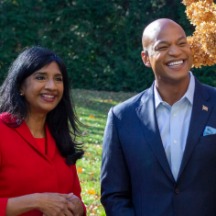Maryland has become a model on how to create inclusive and diverse governor/lieutenant governor tickets ever since voters elected Michael Steele as lieutenant governor. His election in 2002 made him the first African-American elected to statewide office in the Free State.
After defeating Democrat Kathleen Kennedy Townsend and her equally White running mate Charles R. Larson, Steele and his White partner, Robert Ehrlich, became the first Republicans to win in Maryland in almost 40 years. They won 51 percent to 48 percent.
After two terms of yet another mixed-race Republican leadership team with Larry Hogan as governor and Boyd Rutherford as lieutenant governor, this year’s Democratic primary has taken inclusion and diversity to new heights to include several Black women, a Latina, a MENA (Middle East and North Africa), and a Southeast Asian.
All seven male, more widely-known candidates for governor have chosen running mates of a different demographic, other than female, in a state that is White: 55.54%; Black or African American: 29.89%; Asian: 6.28%; and Other race: 4.52%. The current contestants do not exclude Whites, but includes more non-White males and reflect the people in the state they want to serve and represent:
African-American and former Prince George’s County Executive Rushern Baker selected Nancy Navarro, the first Latina to serve on the Montgomery County Council as his running mate. Montgomery County is one of wealthiest and most diverse counties in the USA. Prince George’s County is the wealthiest among majority Black counties.
European-American Congressional staffer Jon Baron chose African-American Natalie Williams, a native Marylander and daughter of Prince George’s County to run with him.
European-American and former Comptroller of Maryland Peter Franchot tapped Monique Anderson-Walker, an African-American Prince George’s County councilperson to run as his lieutenant.
Maryland Governor’s Race: A Model of Inclusion, Not Replacement Theory

Former Maryland Attorney General Doug Gansler designated African descendent Candace Bacchus Hollingsworth as his running mate. She was elected mayor of Hyattsville, a town in Prince George’s County.
African American and former President Obama’s U.S. Secretary of Education John King picked Michelle Siri, a first generation Iranian American and Executive Director of The Women’s Law Center of Maryland, as his running mate.
African-American and former CEO of one of the nation’s largest anti-poverty organizations Wes Moore is running with Aruna Miller. Miller is a former House of Delegates member who immigrated to the United States from India.
Dominican-American and former Obama administration Secretary of Labor Tom Perez is running with African-American and former Baltimore city councilperson Shannon Sneed.
Republicans are also presenting diverse, but all White tickets. Trump endorsed Dan Cox selected another “legal immigrant who escaped communism in Eastern Europe,” Gordana Schifanelli.
Maryland Secretary of Labor and Secretary of Commerce Kelly Schulz is running with small business owner Lt. Colonel Dr. Jeff Woolford. She is the only women running to the top slot.
Also running for governor are Democrats Jerome Segal, Ashwani Jain, and Ralph Jaffe. On the Republican side, there is also Joe Warner and Robin Ficker.
The name "Free State" was given to Maryland in 1919, when Congress passed a law prohibiting the sale and use of alcohol. Marylanders opposed prohibition because they believed it violated their state's rights. The Maryland primary is Tuesday, July 19, 2022.
African American and former President Obama’s U.S. Secretary of Education John King picked Michelle Siri, a first generation Iranian American and Executive Director of The Women’s Law Center of Maryland, as his running mate.
African-American and former CEO of one of the nation’s largest anti-poverty organizations Wes Moore is running with Aruna Miller. Miller is a former House of Delegates member who immigrated to the United States from India.
Dominican-American and former Obama administration Secretary of Labor Tom Perez is running with African-American and former Baltimore city councilperson Shannon Sneed.
Republicans are also presenting diverse, but all White tickets. Trump endorsed Dan Cox selected another “legal immigrant who escaped communism in Eastern Europe,” Gordana Schifanelli.
Maryland Secretary of Labor and Secretary of Commerce Kelly Schulz is running with small business owner Lt. Colonel Dr. Jeff Woolford. She is the only women running to the top slot.
Also running for governor are Democrats Jerome Segal, Ashwani Jain, and Ralph Jaffe. On the Republican side, there is also Joe Warner and Robin Ficker.
The name "Free State" was given to Maryland in 1919, when Congress passed a law prohibiting the sale and use of alcohol. Marylanders opposed prohibition because they believed it violated their state's rights. The Maryland primary is Tuesday, July 19, 2022.
Advertisers | Contact Us | Events | Links | Media Kit | Our Company | Payments Pier
Press Room | Print Cover Stories Archives | Electronic Issues and Talk Radio Archives | Writer's Guidelines






